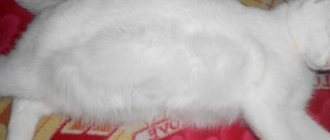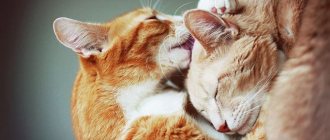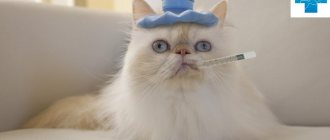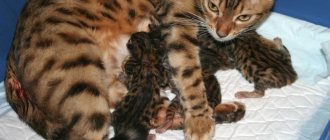Like people, cats also suffer from various dangerous diseases that negatively affect their vision. Blindness in cats may be a consequence of age-related changes in the body that occur in old age. But the problem can also affect young pets. The reasons why a cat suddenly or slowly loses her vision are varied. If the owner notices that the animal’s pupils are constantly unnaturally dilated, react poorly to light, and the animal has difficulty oriented in space, it is better to show it to the veterinarian as soon as possible.
Causes of vision loss
Slow
Cat's eyes have a complex structure, so if the structure of the organ is damaged for some reason, the eye loses its functionality, which, if not treated in a timely manner, inevitably leads to a partial or complete loss of the ability to see.
With some types of diseases, the animal becomes blind slowly, gradually getting used to and adapting to this condition. Gradual blindness in a pet can develop against the background of such dangerous pathologies:
- Malignant neoplasms in the eye or brain tissue. With this disease, the eyeball may increase in size or move to the side. In addition, the cat has other pathological symptoms: disorientation in space, weakness, drowsiness, weight loss.
- Glaucoma. This is a dangerous pathology in which the animal’s intracranial pressure increases. The cat suffers from chronic headaches and is constantly irritated. As the disease progresses, the field of vision narrows significantly; if the disease is not identified and treated in a timely manner, the animal becomes completely blind.
- Cataract. With this disease, clouding of the lens is observed. Cataracts often develop against the background of diabetes mellitus and helminthic infestation, in particular, when infected with chlamydia.
- Elderly age. An old cat, even if he lives in good conditions, with age ceases to clearly and clearly see objects located in the house. The cat's pupil stops reacting normally to a light stimulus, and the field of vision narrows.
Poor nutrition and vitamin deficiency in a pet can lead to gradual loss of vision.
Other reasons:
- poor nutrition;
- avitaminosis;
- inflammatory diseases of the cornea;
- congenital anomalies of the development of organs of the visual system.
Sudden loss
If a cat suddenly becomes blind in one or both eyes, it is first of all important to rule out injury to the organ of vision, as well as a concussion. Optic neuritis, which is inflammation of the optic nerve, can also negatively affect an animal's ability to see normally. At the initial stage, the signs are not pronounced, but as it progresses, the animal can no longer live a full life because it does not see as well as before.
Another cause of sudden loss of visual function is arterial hypertension. If blood pressure rises sharply, small vessels in the cat's eye become damaged. Excessive hemorrhages appear in the area of the iris or on the whites, which often leads to retinal detachment and a sharp loss of the ability to see the outside world. Other characteristic signs of hypertension: mydriasis, corneal edema, lacrimation, nausea and vomiting.
It is rare, but it still happens that an eyeless kitten is born, which, due to a congenital anomaly in the development of the visual system, is completely missing eyes. Blind kittens, in addition to the fact that they do not see anything, are no different in growth and development from their sighted relatives. There are cases where a blind pet had free access to the street and successfully hunted using only hearing and smell.
How to live for blind cats
Cats can lose their vision for a variety of reasons, and although in most cases it weakens with age, a kitten can also go blind. Visually impaired cats adapt well, especially if we help them.
There are a number of diseases that can lead to vision loss, even loss. The first thing that comes to mind for owners is various eye injuries.
From the point of view of specialists, an important role is played by diseases of the conjunctiva of an allergic or infectious nature (including neonatal conjunctivitis), eye infection caused by the herpes virus, tumors, of which the ophthalmologist especially notes retinal melanoma.
Conditions such as glaucoma (increased intraocular pressure) and cataracts (clouding of the lens, preventing light from reaching the retina) affect cats just as they do humans. A general increase in blood pressure can also have a detrimental effect on vision (hypertension can be a consequence of diabetes, kidney disease, hormonal disorders and other general diseases).
Of the hereditary disorders, the first thing to remember is progressive retinal atrophy, an incurable disease that gradually leads to complete loss of vision. It progresses gradually and painlessly, so no significant changes in the cat’s behavior are observed. In general, a cat adapts to vision loss much more easily than a person for completely natural reasons.
The cat is known to be a predator, preying on small rodents in low light conditions. So bad that, according to human estimates, nothing is visible. But a cat's eye sees in the dark 6 times better than ours.
Hearing, smell and touch are also very important; the night hunter uses them for orientation in space to a much greater extent than animals active during daylight hours. This explains the greater ease of adaptation to vision loss - those organs and analyzers that must take on its work are already sufficiently trained.
Over time, a blind cat’s hearing and sense of smell become even more acute, and its “whiskers” (vibrissae) increase by 30%. If vision loss occurs gradually, then in a familiar environment the cat can navigate no worse than a sighted cat. Owners notice something is wrong after repairs or rearrangements, when their pet suddenly starts bumping into everything.
But in the case when blindness occurs abruptly, suddenly, the owner is simply obliged to notice changes in the animal’s behavior. The cat walks, bumping into furniture, does not immediately find a bowl and tray; If only one eye is affected, sudden and unexpected movements from the affected side frighten the animal. When keeping a blind cat in the house, certain rules must be followed:
Unchangeable situation.
A cat that has lost its sight relies very heavily on its memory, on its familiar “map of the area.” Changing the arrangement of objects in a house where cats with poor eyesight live is strictly not recommended. The bed, bowls, toilet, scratching post, and toys should be in their usual places.
When rearrangements cannot be avoided, show your cat the way to the new place more than once or twice. If the room is unfamiliar (moving to a new apartment, for example), you need to patiently accustom the cat to each place, placing it next to it (directly in the tray - in the case of a tray) and allowing the cat to find its way from these most significant objects to others parts of her possessions.
Safe environment.
Blind cats should not be allowed near dangerous places, and they should be retrained to go down stairs. It is very easy for a disorientated animal to fall from a staircase or balcony. Approaches to the fireplace, exits to the balcony, and staircase must be blocked. Remove all sharp objects and wrap something soft around dangerous corners. There should be nothing unnecessary on the floor - now this is not only a matter of order, but also of convenient movement of the cat around the house.
No lonely walks.
A blind cat should not walk on its own! Only with the owner and on a leash. Train your cat to wear a harness. In addition, securely attach a tag with your phone number and information that the cat is blind to the harness or collar (the collar is not for attaching a leash!). Blindness will not prevent her, when frightened, from rushing in an unknown direction, and it is unlikely that you will be able to catch her, so make sure you are as safe as possible.
If a cat lives in a country cottage, then it is better for her to have a well-fenced and landscaped enclosure on the property. You can only let your cat free-range in an area where the cat is familiar with everything if you are 100% sure that the fences are cat-proof and that you have removed or securely covered all dangerous objects, pits, pools and other potential hazards. Still, it’s better not to leave your cat alone outside.
In cats that have lost their vision, other senses become more acute: smell and hearing. This is a natural compensatory reaction and should be used to help your cat navigate the house. For example, you can “mark” rooms with different subtle scents so that your cat always knows where he is.
Strong and unpleasant odors should be avoided! Also try to avoid loud, frightening sounds, and if this still fails, for example, something fell with a crash, find the cat and pet it so that it calms down.
Talk to the cat!
This gives her a feeling of security and calms her down. She hears that someone has entered the room - say something to her, let her know that it is you! Talk to her before petting or picking her up, otherwise she may get scared out of surprise, not accept affection, and even bite or scratch. A blind cat can become a “Velcro” cat - constantly following its owner, using him as a guide. In this case, inform your cat when you leave the room, making the task easier.
A blind cat may also rely on other cats to navigate around the house. If there are several animals in the house, you can put collars with bells on them to warn the cat of their approach with a characteristic sound.
Games are required.
Blind cats lead a less active lifestyle and actively gain weight. To maintain physical fitness, play with them more. Cats begin to navigate by sounds; they like rustling, mouse-like squeaking, buzzing toys, bells, and rattles.
Blind cat playing with toys
Live and rejoice
In Gwen Cooper's book "Homer's Odyssey"
tells the true story of a blind kitten who moves freely around the house, makes friends with two other cats, catches flies better than them, and generally lives a full life as a cat. Here's how Gwen writes about him:
"What a pity!" - I often hear when people learn that Homer lost his sight at the age of two months. To which I immediately respond: “Show me a more cheerful cat, and I’m only for watching!” “I’ll give you a hundred dollars right away.” No one has yet encroached on this amount.
“Yes, but how does he... uh... get out of the situation?” - usually follows a question. “On my own four,” I answer, “like any other healthy cat.”
It happens, however, that if Homer gets too excited, I hear a dull thud - a bale! This means that his head hit the wall or the leg of a chair, which he forgot about in the heat of the game. Now this sound makes me smile, although my heart skips a beat out of habit. But who among you could resist smiling at the sight of your cat, having played out, plopping off the sofa, pulling the blanket behind him, or at the way he stunnedly examines the glass door that he was eager to meet in pursuit of an invisible goal? PAN KAZIMIR
Nine-year-old Kazimir
(to relatives and friends simply Kuzya) is the child of Siberian-Persian love. He has a rare chinchilla color and an equally rare ideal disposition.
“The only cat that never gave me a scratch. Even as a child, when playing, he did not let go of his claws,” says Kazimir’s owner. — At the same time, you can’t call it “Velcro” either. He is unobtrusive and does not seek to take a place on your lap. Self-sufficient cat. Casimir always treated other animals kindly, one might say patronizingly, but again he did not suffer from excessive sociability.
Although, when a small cat appeared in the house, he certainly turned into a voluntary nanny.” Let’s say right away: no misadventures could spoil Kazimir’s character.
And they started four years ago - with one unhappy walk. Since Kazimir’s house is located in a place that fully corresponds to the description “quiet and green,” no one blocked the cats’ access to the street.
And the neighbor’s call: “Kuzya is hobbling home, come out to meet him, otherwise he won’t reach the door,” sounded like a bolt from the blue. The veterinary clinic diagnosed a concussion and deformation of the eyeball and said that a person had contributed to this using a stick or stone...
The damaged eye was removed. Left with one eye, Kazimir first settled on the terrace and looked out the window. It is clear that from that moment no one allowed him outside. At home he behaved as usual, except that he looked around, turning his entire head and, if he heard some sound from the direction of his missing eye, he jumped back slightly.
And everything would have been fine, but four years later problems began with the remaining eye. This spring, conservative treatment could no longer contain the pathological process, and the second eye also had to be removed. Complete blindness set in, but by this time the cat already had familiar, well-mastered routes for moving around the house.
Still, the vision in the last eye gradually decreased, and he most likely stopped seeing even before the operation. But in the cat team, or rather, on its hierarchical ladder, some rearrangements could not be avoided.
However, these changes are inevitable when the second male grows up. The younger cat (who appeared shortly after the removal of Kazimir’s first eye), having reached puberty, began periodically swinging at his older comrade near bowls and rookeries.
But this is so, just raise your paw, at the very least a light slap in the face. There were no fights or other bloodshed (perhaps because everyone is now castrated). The fair half of the pride is absolutely indifferent to male squabbles. Kuzya’s daughter dotes on him, and the cat Lisa simply proudly ignores everyone (as always). BLIND MUSICIAN
Six-year-old blind cat
Stevie Wonder
, named after the famous American singer and composer, loves to press the piano keys. He exercises every day in the house of one of the employees of the Greenwood shelter for homeless animals (Cambridgeshire, UK). And the shelter staff, while looking for Stevie’s permanent homes, enjoy attending his concerts.
Blind Cat Rescue
This shelter in North Carolina (USA) was created in 2005 to provide shelter to cats whose vision was assessed as 20% or less of normal, which was why they were not accepted into regular shelters.
“Blind cats are animals that simply cannot see. They have no idea that they are blind. They know they are cats. They act like cats, says the Blind Cat Rescue manifesto. “Blind cats can do almost everything that a seeing cat can do.”
Ekaterina SAVITSKAYA
How to determine pathology?
An unsteady gait and cautious, slow movements may indicate the animal is blind.
If an old or young cat for some reason has ceased to see normally, you can understand that something is wrong with the animal by the following symptoms:
- Careful, slow movements in a familiar room.
- In an unfamiliar place, the animal tries not to move, looks closely for a long time, and bumps into objects.
- The cat refuses to jump or climb to heights.
- The gait becomes unsteady.
- The gaze is cloudy, the pupils are large, and do not respond to light stimuli.
- The cat becomes shy, fearful, and nervous.
How does the sense of smell compensate for the lack of vision?
Another analyzer that plays an important role as a compensator for lack of vision is the sense of smell. With its help, the cat will navigate where the food is and where its tray is. Therefore, the first few times you will need to take the kitten to the tray yourself and not immediately remove it. The smell will allow the baby to navigate where to go next time.
As for old cats that were trained to use the toilet while they were still sighted, they rarely have problems finding it. After all, they have walked a familiar route many times, and are able to reach it (or, say, their bowl) without thinking. In this case, it is not recommended to change the location of important objects for the cat: toilet, water container, food bowl, favorite resting place (house, chair, etc.)
Diagnostics
If the owner, based on characteristic symptoms, notices that not everything is in order with the visual function of his four-legged friend, it is necessary to find out an accurate diagnosis as soon as possible and begin treatment. Therefore, you should first visit a veterinarian who will conduct an initial examination and then give a referral for a comprehensive diagnosis. The following methods will help check the condition of the visual system:
- ophthalmoscopy;
- electroretinography;
- Ultrasound of the eyeball;
- MRI of the brain;
- blood pressure measurement.
Signs of blindness
A cat's blind eye is often covered with a veil, or the pupil remains dilated even in bright light.
The animal will not be able to say that it sees poorly. However, a person can determine by certain signs that a cat has lost its sight:
- the animal stops moving a lot and spends more time dozing;
- walks only on the floor, jumps less or not at all;
- walks around the house carefully;
- The blind cat's whiskers are broken off. This is due to the fact that the whiskers are the main sensory organ of a blind cat. With them she feels the world, catches vibrations in the air;
- eyes do not glow in the dark;
- while moving, it crashes into objects that are not located in their usual places.
A cat that is blind in one eye may lash out in self-defense if you make sudden movements on its blind side.
What to do to restore the animal's ability to see?
Drug treatment of pathology depends on the causes of its occurrence, in some cases they resort to surgery.
The treatment regimen depends entirely on the established diagnosis. If the cause of blindness is inflammatory processes in the body, a course of antibiotics and anti-inflammatory drugs is prescribed. For glaucoma, therapy is aimed at reducing ICP; normalizing blood pressure will be necessary if hypertension is the root cause of the pathology. For cataracts at the initial stage of development, the doctor prescribes special ophthalmic drops; if the disease is advanced, you will have to undergo surgery to replace the lens.
Causes of blindness
Veterinary statistics note: in 90-95% of cases, vision loss in cats is acquired. The main risk factors leading to blindness:
- injuries that damage the tissues of the orbit;
- ophthalmic tumors;
- defects in the development of the optical system of the eye, the most dangerous of which are glaucoma (occurs due to excessive intraocular pressure) and cataracts (manifested by clouding of the natural lens - the lens due to impaired metabolism, infectious diseases, uncontrolled use of drugs);
- retinal detachment, often caused by heredity;
- inflammation of the cornea (keratitis), blood vessels (uveitis), nerves (neuritis);
- damage to the organs of vision by chlamydia - the simplest microorganisms of urogenital nature;
- pathologies and brain injuries that can lead to disruption of connections between the central nervous system and eye receptors;
- diabetes mellitus, leading to many degenerative consequences, including low vision or complete loss of visual function;
- vitamin deficiency, often observed in weakened, malnourished individuals;
- old age, at which many cats with a low level of immunity become blind.
In some pathological conditions - strokes, injuries - blindness can occur at lightning speed. With others - diabetic cataracts, glaucoma, retinal atrophy, ocular neuritis - visual acuity is gradually lost. In the latter case, the animal has time to get used to and adapt to low vision and blindness. Other sense organs come to the aid of the eyes - ears, nose, whiskers.
How to care for a sick pet: features
Blind cats that live in an apartment or house often adapt to this situation. It is important for the owner to follow certain rules and, of course, love his pet. First of all, you should give up free range. If your cat likes to walk outside, this can only be done with a leash. It is recommended not to make drastic changes in the apartment, so as not to disorient the cat. Young blind cats love active play, so it is recommended to use toys that make sound signals. Otherwise, you need to care for such animals in the same way as healthy relatives. Don't forget to visit your doctor periodically.
How does hearing compensate for the lack of vision?
Let's start with the fact that cats (especially kittens with childhood disabilities) do not lose their hunting instincts and do not stop wanting to play. Therefore, any toys that “determine” their location will come to the rescue. These could be cat rattles or squeakers. But remember that when hearing performs a compensating function, it becomes too sensitive. Any sharp sound can be perceived by a cat as danger. Therefore, if the toy is too noisy or squeaks too loudly and unpleasantly, it may frighten the pet.
By the way, it is worth calming a blind cat if you accidentally dropped something loudly, broke something, or even in the event of a quarrel among household members. For the same reason, a cat may hide in a secluded place if guests come to the house and unfamiliar voices are heard, especially a male bass voice.
Make it a rule to warn a blind cat that you are entering the room, going to pet it or pick it up. And in general, communicate with her more, so that she understands that her own owner is nearby, who will not harm her. Therefore, she is completely safe and can relax.
Here's how he does it:
Here's an example of how he climbs onto the sofa. Appreciate the gracefulness. At the same time you can hear him rumble pic.twitter.com/7B8TZyyyI5
— catunderhood (@catunderhood) January 21, 2020
However, mobility problems sometimes occur. One day, no one was home, and the cat climbed onto the partition and could not get down. After this, the owners began to play it safe. By the way, Jim understands if the door is closed, and will sit in front of it and ask to be let in.
Overcoming blindness from birth
A creature born without visual function or blinded early needs constant care. In an urban environment, it is not difficult to provide such care, especially since the kitten quickly gets used to a familiar environment.
It is important to rearrange furniture in the apartment less often. Free walking of the pet is also excluded. A tailed disabled person should exercise only with the owner guiding him with a leash.
Such a companion will follow the person always and everywhere, like a devoted dog. A blind pet's excellent hearing will allow it to instantly respond to its owner's voice. A blind animal will not refuse toys equipped with sound signals.
A little later, the cat dared to independently explore the room
Within a week the cat got used to it. The very next day he began to climb onto the sofa and bed. At the same time, it is easier for a blind cat to climb up than to go down. In the first case, he can feel with his paws and assess the situation, but when jumping down, this will not work. At first, pillows were placed everywhere for him to create a semblance of a step. Vibrissae help the cat navigate. And in general, Vladimir notes that cats rely more on hearing and smell.











